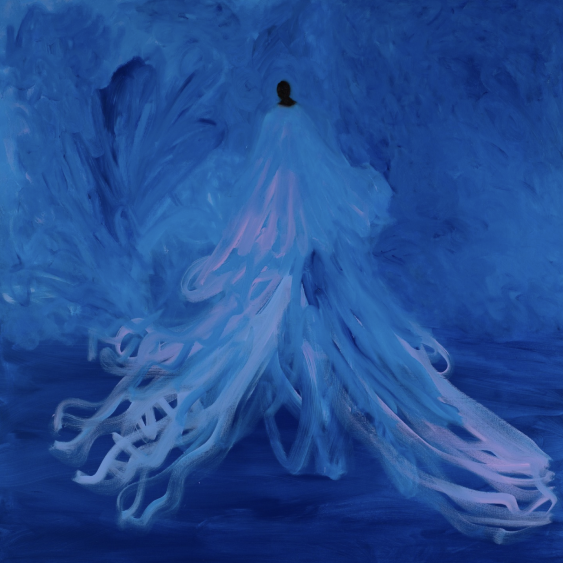Exhibition of Interest
How Whiteface reads meta-cringe, scary but true
with Candice Breitz
Share


Identities. Forums. Area codes. Nationalities. Fads. The platonic, domestic, corporate and romantic. Aesthetics. Routines. Diagnoses. Accomplishments and failures. These and more are the communities in which the individual partake in. Working primarily in video and photography, Candice Breitz examines the individual and the ways they manifest in or form communities. In Whiteface, a presentation currently exhibited at Goodman Gallery in Cape Town, the community in question is whiteness. Employing the public archive, repetition, immersion, uniformity, and interminability, Whiteface is a portrait of white rage, privilege, fragility and guilt. In this week’s Of Interest, Breitz talks about embodying white panic, studying linguistics, autoethnography, and social constructs as lived performances.
Describing her current solo at Goodman, Whiteface, Candice Breitz says, “I think of the work as an awkward stab at autoethnography.” Considered a form of qualitative or arts-based research, autoethnography is a genre of academic research where a person connects with a community’s cultural, political and social constructs with the goal of presenting their findings in an autobiographical fashion. Although this approach can offer a hot take, as marginalised groups increasingly tell their own stories, autoethnography has been flagged for being self-indulgent, narcissistic and too individualised, all in addition to presenting observer bias as a sound survey. Read for its autoethnographic potential, Whiteface’s offering is double-edged. An opportunity to address being socialised as a white South African, Whiteface also immerses audiences in the hysteria that is white neo-Nazi anxiety in response to the promotion of black agency, love, reclamation and recovery. She offers FNB Art Joburg more details below.
Let’s talk about Whiteface. How would you describe the context you were in when you decided to make Whiteface come to life? What research, circumstances or urges informed the show?
The work is informed by (and responds to) the moment in time that we’re living through at present, in societies built on white supremacist ideology. Whiteface observes the ongoing and vicious backlash against anti-racist movements, as white people struggle to come to terms with public discourse that highlights phenomena such as ‘white privilege,’ ‘white fragility,’ ‘white rage’ and ‘white guilt.’ The piece is a portrait of whiteness in a state of panic. It grows out of an archive of found footage fragments that document white people talking about race, and includes the voices of prominent political figures, news anchors and talk show hosts, as well as those of lesser known and anonymous YouTube bloggers, covering white perspectives that run the gamut from neo-Nazi ideology and far right propaganda to everyday racism and the posturing of ‘good white people.’ Rather than grounding the piece in the specific context of South Africa, I have—this time around—wanted to think about ‘global whiteness,’ the kind of contemporary whiteness that is disseminated and perpetuated via the matrix that is the media—social media, mainstream media—in all its virality. The focus in Whiteface is on voices that can be traced back to British empire. It is a study of the English language as a repository for the linguistic violence that underwrites white supremacy.
How would you describe the public’s reception to Whiteface when you showed it abroad?
There have been a very wide and varied range of responses to the work in each context where I’ve been able to share it. I can’t generalize about this.
In Whiteface you ventriloquised white voices representing strands of ‘white privilege,’ ‘white fragility,’ ‘white rage’ and ‘white guilt’. Can you tell me about the decision to use your body in the commentary?
This was, perhaps, the simplest decision when it came to how to stage the work. There was no way to make this work without acknowledging my own embeddedness in whiteness. Including myself as a member of the otherwise wigged-up cast, serves this purpose. I think of the work as an awkward stab at autoethnography.
There’s a sense of the meta-cringe that comes through when viewing Whiteface. Maybe it’s the wigs, maybe it’s how ridiculous the subjects sound. Either way, it’s a picture people can’t help but look at, even though it makes them squirm. Did putting this together have a similar effect on you?
Meta-Cringe! I like that term very much. I’ll have to borrow it from you! I’m not sure it’s possible to address whiteness without the cringe factor at this point in history. Yes, absolutely, I swam through endless cringe as I was making Whiteface, but that was not the dominant emotional experience for me. I’d say that nausea and anxiety were far more primary. After all, I was socialised—as a white South African—to internalise and perpetuate the violence at the ‘Heart of Whiteness’ (to borrow a phrase from Njabulo Ndebele); so, I could hardly afford myself a huge amount of distance from the white zombies that I play in the piece. Ventriloquizing the toxic contents of the script through my own body over a ten-day shoot was a chosen and deliberate experience that I felt was necessary for the work. The experience was nevertheless painful and extremely grotesque.
I’m curious about the title of the exhibition, Whiteface because it seems to be derived from the term blackface which refers to the practice of wearing make-up to imitate the appearance of a Black person. Yes, Black people have been accused of doing this but it often refers to an act being performed by a white person. Could you tell me about how the title came about in relation to the performer being white?
Over the last couple of centuries, blackface has been practiced both by Black people and white people—always to caricature, dehumanize and demean Black people; almost always in order to provide amusement and gratification to white audiences. In the case of Black minstrels, the high demand for such entertainment—especially (but not only) in the American context—made the performance of blackface a means via which to earn income, as painful as it is to register this historical reality from a contemporary perspective. There’s no doubt that blackface—as a long and ugly tradition—is a mode of punching down at those who it objectifies. Could whiteface, on the other hand, serve as a mode of punching up? This is one of the questions that Whiteface poses. We know that race is a fiction… unfortunately, one that continues to exert very real and violent consequences. My use of the title, Whiteface—along with the costumes worn in the piece—is an invitation to think about whiteness as a social and historical construct, as an exertion of power that white people consciously or unconsciously perform, aided and abetted by societies that have been engineered to enshrine whiteness as a superior form of being.

With the above question in mind, is bringing the condition of whiteness into visibility more of a distancing critique or a reflection?
Each person encountering the work will have to decide this for themselves. There is no easy answer to your question.
There is a uniformity to all the characters i.e the platinum blonde wigs, the white iris contact lenses and white shirts. Is there a reason they’re uniform? Still on the characters’ look and feel, their lack of irises almost gives them an alien-hood that distances them from humanity. When look a lot like humans but with this slight difference, they could be anything. Is there a significance to the look of their eyes?
Given that the work riffs off practices of blackface, which radically stereotype and reduce Black being and brutally deindividuation Black experience, it seemed appropriate to have Whiteface apply the same kind of infuriating reduction to whiteness. The platinum wigs and zombie lenses are intended to disengage any empathy for the characters in the work; as is my exaggerated, plodding performance. They move the work in the direction of satire and—if the work is received as I hope it might be—locate it within the genre of horror. It is not specific white people who are the primary target of Whiteface. Rather, it is the condition of whiteness that the work seeks to prod into visibility. Whiteface is less a portrait of the people whose voices are appropriated within it, than a study of the operating systems that sustain whiteness, a survey of the language via which whiteness frames, normalises and leverages its power. The uniformity of the costumes speaks to my attempt to address white supremacy as a system of power, rather than a condition that can be effectively eliminated simply by tackling racist individuals.
In your interview work, for instance with TLDR, how do we draw the line between what you do and journalism? This is in regard to your process, results, the relationship you have with subjects, ethics and distribution platforms?
I’m not too interested in drawing lines, so I’ll leave it to you to decide where the distinctions between art and journalism lie. I’m certainly grateful to be free of certain assumptions that are common within mainstream journalism: I don’t feel at all beholden to conventional ideas of ‘truth’ or ‘objectivity,’ for example, as I conduct an interview. I’m more interested in how extended interviews can serve as a mode of narration, than I am in using interviews as an evidential tool. In terms of the ethics of conducting interviews, at least within my own practice, it’s imperative for me that interviewees have a full and complex understanding of why they are being interviewed prior to the interview taking place, and that they are granted full control of how much they wish to share and of what they wish to exclude from their answers. I never ask an interviewee to formally grant me permission to use their interview until the interview is over, to ensure that they’re comfortable with how the interview evolved. I regard the interviewees who appear in my work as collaborators, rather than as resources.
You have been referred to as a visual storyteller working in the medium of video a few times. If this is the case, what is your function for storytelling?
There are as many ways to tell a story, as there are stories to be told. I always allow the particularity of each project—and the priorities attached to it (the ends towards which each story is being told)—to dictate the framing and articulation of that story.
How do you negotiate power and privilege when telling the stories of the disempowered in your practice?
The strategies that I draw on to reflect my privileged position, are always particular to the context that I’m negotiating, as well as to the exact nature of my relationship with the individuals who I encounter within each specific context. I don’t think it would be helpful for me to throw out wild generalizations here, without reference to particular works or situations. I will say, as somebody who spends a great deal of time looking at and thinking about contemporary art, that I’ve personally reached a point of saturation when it comes to privileged artists stepping into marginal communities without any consideration of how their privilege shifts the dynamics of the dialogue with their subjects. In situations where there is a power asymmetry between the person looking through the camera and the people in front of that camera, there needs to be a nuanced reflection on how privilege is built on (and mostly perpetuates) power disparity, and this has to manifest tangibly within the work, at least to keep this particular viewer engaged. In the end, the big question for an artist like myself—privileged, white, middle class—is how and whether one can dignify those one portrays, without simply perpetuating harm and extracting value from an entitled perspective.
Subscribe
Subscribe
For exclusive news, tickets and invites delivered every week


